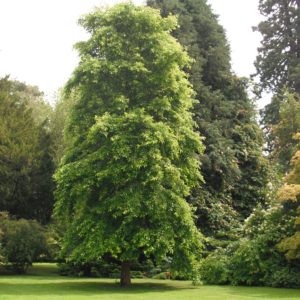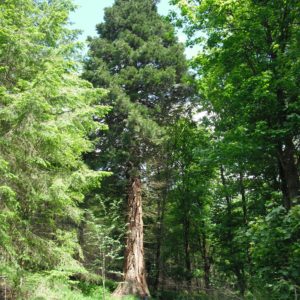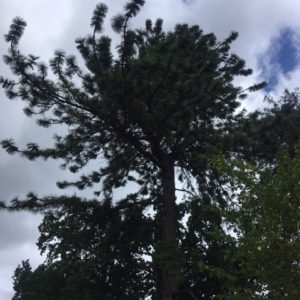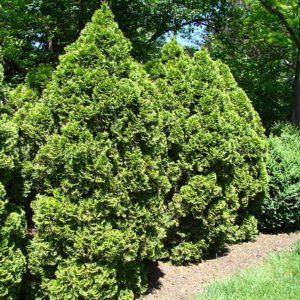-

Tree of Life or Chinese Arborvitae Seed
Thuja orientalis£6.50 inc. VATThe Tree of Life or Chinese Arborvitae is a small slow growing conifer that is often grown as an ornamental. It makes a close, even, broad conical shape. In its native China it is associated with long life and vitality – hence its name of Chinese Arborvitae or Tree of Life. It is often planted in cemeteries and graveyards in UK. Foliage fronds are made up of flat scale-like leaves which are citrus aromatic when crushed and in a hard winter turn brownish green. The timber is quite pale and easy to work, being soft.
Pic by Fanghong, CC BY-SA 3.0 , via Wikimedia Commons
-

Tree Peony Seed
Paeonia ludlowii£4.50 inc. VATLudlow’s Tree Paeony is sometimes known as Paeony lutea ludlowii and in its native Tibet as ‘God’s Flower’ is a large, slow growing, deciduous shrub. It has ferny leaves with good yellow autumn colour and produces numerous large, open yellow flowers, a bit like poppies, from early to late summer. It is tolerant of most things but won’t flower in deep shade. No pruning is necessary, just the occasional tidy up, the branches are generally unbranched.
-

Tulip Tree Seed
Liriodendron tulipifera£5.50 inc. VATTulip Tree is a fast growing beautiful large deciduous tree. Leaves are shaped like cartoon tulips and turn yellow in autumn. The flowers appear from early summer onwards resembling short stemmed tulips or Magnolia. They are a yellow green colour and banded at the base of the petals with orange. Very tolerant of pollution, so where there is space, this is useful as an urban tree.
seed sold is de-winged
-

Tupelo, Black Gum Seed
Nyssa sylvatica£2.00 – £4.50 inc. VATTupelo or Nyssa sylvatica is a neat deciduous tree forming a symmetrical pyramid shape, later spreading. Insignificant flowers are a source of nectar for insects. The autumn colour is spectacular turning purple, orange, yellow and red.
-

Turkey Oak Seed
Quercus cerris£8.00 – £22.00 inc. VATTurkey Oak is a large deciduous tree and one of the fastest growing oaks. It thrives on chalky soils and near the sea. The leaves are coarsely toothed and slightly rough to the touch and the acorns are bristly/hairy, looking like bad-hair-day hedgehogs. Mature trees have fissured and plated bark.
cup pic courtesy of Javier martin, Public domain, via Wikimedia Commons
leaf and acorn Javier Martin, Public Domain
Not for forestry purposes.
-

Turkish Hazel Seed
Corylus colurna£5.00 – £10.00 inc. VATTurkish Hazel is a remarkable deciduous tree with a striking symmetrical, pyramidal form. The corky, deeply fissured bark is also an attractive feature. It is the only hazel with a single straight trunk rather than being multi-stemmed. It doesn’t coppice like the European Hazel.
-

Umbrella Pine Seed
Sciadopitys verticillata£2.50 – £9.50 inc. VATA curious conifer native to upland areas of two of the large Japanese islands. The needles are made up of two fused leaves and appear upside-down in that their shiny surface faces downwards.
-

Urn Gum/ Urn Pod Gum Seed
Eucalyptus urnigera£10.00 inc. VATEucalyptus urnigera, Urn Gum or Urn Pod Gum, is considered to be more decorative than E. gunnii. It makes a good specimen tree with silver-blue round juvenile and strap-like silver/grey-green adult leaves. Silver white bark matures to green-grey-white-gold-pink, mottled and peeling. Flowers are white in September from urn shaped buds and the seed cases are urn shaped too. The largest UK specimens grow in the warm damp weather of the Western Scottish Coast.
-

Victorian Silver/ Buxton Gum
Eucalyptus crenulata£6.50 inc. VATA medium sized evergreen tree which can be used as hedging or coppiced for floristry. Compact grey-green, wavy edged foliage turning to green with reddish hints as it matures. White, fluffy, scented flowers in spring. Smooth bark.
-

Vine Maple Seed
Acer circinatum£6.00 – £25.00 inc. VATVine Maple is a fine, medium sized deciduous tree with elegant and graceful habit. It can also be grown as a large, multi-stemmed shrub. The small, lime green flowers in tassels in spring are followed by red, winged, sycamore -like seeds. The fresh green leaves are rounded but lobed and turn fantastically bright in autumn – reds, oranges and yellows. It is perfect species for bonsai.
-

Virginia Creeper Seed
Parthenocissus quinquefolia£5.00 inc. VATVirginia Creeper is a large growing, self-clinging vine ideal for high walls. The deciduous leaves are made up of 5 leaflets, mid veins of which are greyish. They turn a brilliant orange or scarlet in autumn. The fruits are a blue / black colour. It needs very little maintenance.
-

Virginian Witch Hazel Seed
Hamamelis virginiana£5.00 – £10.00 inc. VATVirginian Witch Hazel is the commercial source of Witch Hazel and can range from a large multi-stemmed shrub to a small tree. The flowers have a soft sweet perfume when they appear in the late autumn, with narrow pale yellow crumpled petals. They are a useful food source for late insects. The large simple leaves colour well in the autumn. Witch Hazel ointment is an extraction from the bark in alcohol and can be used to calm skin irritations and reduce inflammation.
-

Wayfaring Tree Seed
Viburnum lantana£7.00 inc. VATThe Wayfaring Tree is a large native, deciduous shrub often seen in hedgerows. The ovate leaves and young shoots are covered with a dense tomentum or down. Leaves sometimes turn a dark crimson in autumn. The cream flowers appear in late spring and are followed by oblong fruits that mature from red to black.
-

Wedding Cake Tree Seed
Cornus controversa£7.00 inc. VATThe Wedding Cake Tree when grown in the right conditions, semi-shade and dampish, can grow into quite a large shrub. It makes a wonderful architectural shape with tiered and layered branches. The cream flower heads in summer are flat too, adding to the layered effect. Good purple autumn colour. Slow growing and needs space to develop the right shape.
-

Wellingtonia Seed
Sequoiadendron giganteum£5.00 – £15.00 inc. VATWellingtonia is a Californian giant, not as tall, but with a wider girth than the Californian Redwood (Sequoia sempervirens) Young specimens are conical and densely branched producing a large elegant evergreen tree. The leaves are similar to Leyland cypress, being shortish hard scales. Thick rusty coloured fibrous bark, fissured and ridged when mature, but very soft.
-

Western Hemlock Seed
Tsuga heterophylla£5.00 – £15.00 inc. VATWestern Hemlock is a large fast growing conifer with spreading branches. It produces an outstandingly beautiful single specimen tree with an elegant spire-like crown. The leaves are marked with two white bands underneath, soft and a bit like Yew but are aromatic(grapefruit or citrus) when crushed. Associated with Douglas Firs and Sitka Spruce on the Pacific coast of America, growing in the shade of other trees. When young, growth is slow, but picks up after 2 or 3 years.
-

Western Red Cedar Seed
Thuja plicata£5.00 – £15.00 inc. VATWestern Red Cedar is a large fast growing tree with shredding bark and spreading branches. The leaves are bright glossy green forming an excellent hedge which clips well. Foliage is aromatic. Trees are grown commercially for cutting into planks for cladding and fencing and shingles. The timber is very resinous so doesn’t rot.
pic courtesy of Baummapper, CC BY-SA 3.0 , via Wikimedia Commons
-

Western Yellow Pine Seed
Pinus ponderosa£6.00 – £15.00 inc. VATWestern Yellow Pine is a large striking conifer with a scaly cinnamon bark and drooping branches. Planted as an ornamental tree in large gardens as well as for timber production in its native western North America. Needles grow in threes and even when old the crown is narrowly conical. The bark is said to smell of turpentine, but not as strongly as Pinus jeffreyii.
-

White / Weymouth Pine Seed
Pinus strobus£5.00 – £10.00 inc. VATWhite or Weymouth Pine is usually planted in gardens and parks as a specimen tree. It has very short dark green needles, in bundles of 5 and the cones are slender and brown up to 15cm long. It is fast growing and ornamental. In the past it has been used as a timber tree, and still is in America. It was used for the masts of sailing ships and was the cause of The Pine Riots in the American Civil War, because the colonists objected to the export of the finest trees to England! (early trade wars?!) Called the Weymouth Pine after Captain Weymouth who first brought the seed back the England, not because of where it grows!
pic courtesy of Famartin, CC BY-SA 4.0 , via Wikimedia Commons
-

White Cedar Seed
Thuja occidentalis£5.00 – £10.00 inc. VATThis is an extremely hardy evergreen forming a medium sized columnar tree or hedge. It has spreading branches that curve upwards at the tip with dark green upper surface foliage; the lower surface being a light yellow. Foliage smells of cooked apples with spices. Brought over from America in about 1540.
pic courtesy of Dan Keck from Ohio, CC0, (public domain)via Wikimedia Commons
-

White Mulberry Seed
Morus alba£3.00 inc. VATWhite Mulberry is a medium to small tree with lance shaped leaves up to 15cm wide that are the traditional food of silkworms. It grows fast and is quite short-lived – 50 to 80yrs on average. Catkins turn into whitish fruits in the early autumn, changing to pale pink later and are edible. If necessary, prune in late autumn or early winter, other wise the stems bleed.
caterpillar pics courtesy of Srithern /CC BY-SA via Wikimedia
-

White or Downy Birch Seed
Betula pubescens£5.00 inc. VATDowny Birch thrives on a wider range of soils than Silver Birch, particularly damp soils. It is white barked and similar to Silver Birch but with a more upright growth habit. Younger specimens usually exhibit downy undersides to the leaves and on the stems. It is useful as a pioneer species for planting in difficult and exposed sites.
Not for forestry purposes.
-

White Spruce Seed
Picea glauca£5.00 – £19.50 inc. VATWhite Spruce is a very hardy species and quite variable. Stubby needles are densely packed and on some trees are green and some blueish grey and anything in between. It has a narrowly conical growth habit when mature, with branches that ascend at the tip. In Canada it is an important timber tree for building and pulp and in Japan the wood is used for making boards for the game ‘Go’
pic courtesy of USDA-NRCS PLANTS Database / Herman, D.E. et al. 1996. North Dakota tree handbook. USDA NRCS ND State Soil Conservation Committee; NDSU Extension and Western Area Power Admin., Bismarck, ND., Public domain, via Wikimedia Commons
-

Whitebeam Seeds
Sorbus aria£5.00 – £10.00 inc. VATWhitebeam makes a neat, oval headed tree with grey hairy leaves. It is often planted in streets and gardens. Heads of white flowers in May develop into red berries for the autumn but they are usually eaten by birds before they ripen! Autumn colour is yellow then brown.


Sign up to receive great news and offers